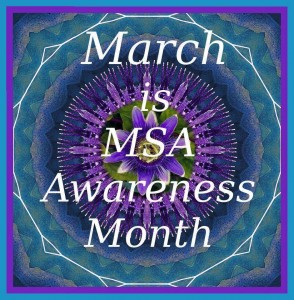March is Multiple System Atrophy Awareness Month
Miracles for MSA request public support in spreading the word about this rare and fatal neurological disease and the desperate need for research. Time is running out for those currently diagnosed.
FOR IMMEDIATE RELEASE
(Press Release) – Feb. 13, 2013 – This March marks the 4th annual Multiple System Atrophy Awareness Month. Miracles for MSA urgently request public support to create greater awareness of the need for research funding to aid in discovering the cause and cure of this fatal neurological disease.
“Multiple system atrophy (MSA) is a rare disease with approximately 15,000 diagnosed patients in the US ( equivalent to 1000 in Australia) at any given time”, says Don Crouse, board member of the MSA Coalition. “As many as 35,000 more are misdiagnosed with another disorder”.
MSA results in the degeneration of nerve cells in several regions of the brain that affect abilities most people take for granted. Initial symptoms may include loss of balance, fainting due to severely low blood pressure, bladder and bowel issues, speech and swallowing difficulties, sleep disturbances, breathing problems, rigidity and tremors. These symptoms often lead to a misdiagnosis as Parkinson Disease.
“Several years ago MSA (Multiple Systems Atrophy) entered into our family” says Mac Keenan of Wangaratta “ My wife Jill came home and was upset because she was having trouble writing on the blackboard and her students could not read it, following this she had a several falls. After many visits to our GP and neurologists she was finally diagnosed with MSA. It has slowly progressed affecting her writing, speech, walking, bladder and blood pressure to the point she is now wheel chair bound and requires 24/7 care.Over the course of 5 to 10 years, victims are robbed of their ability to walk, talk, chew, swallow and breathe. There are no medications available to stop its relentless progression“There isn’t an aspect of your life that MSA doesn’t affect, it takes away your femininity, your pride – it takes away you” says Jill. There is no cure yet and because it is so rare (4 in 100,000) very little money is available for research.
Research Funding Desperately Needed
Because of the rarity of Multiple System Atrophy, research experts around the world are having a difficult time finding funding for their urgently needed work. “As far as we know, there are no celebrities that are affected by Multiple System Atrophy, this means as members of the MSA community we need to raise money and create awareness at a grass-roots level”, says Don Crouse.
Dr. Charles Ide, researching MSA at the University of Western Michigan, elaborates on the problem, “It’s amazing how many applications for NIH grants I have written over the past 5 years all to no avail. Most of these get good reviews to the point that you expect funding, but for some reason, none is allotted. MSA is still an orphan disease and does not make it to their top funding tier.”
The reality is that patients and their families are left feeling abandoned by the government, the medical establishment and by various support organizations that focus on MSA’s more recognizable neurodegenerative cousin diseases like Parkinson Disease or Alzheimer’s. As well, in order to direct funds to the most relevant MSA research there needs to be more of a concerted effort globally to collect and distribute money to those researchers on the cutting edge. In the US, the Multiple System Atrophy Coalition is taking a leadership role to advocate for changes at the NIH to increase funding of orphan diseases like MSA.
The amount of money required to make a difference to current sufferers is not out of reach. Professor Gregor Wenning, co-founder of the European MSA Study group, a research network of 24 clinical centers in Europe believes, “Even 1 million USD could make a difference, although this is a small fraction of what is available or donated for other orphan diseases such as Lou Gehrig’s disease or Huntington’s disease (see Cure HD Initiative, CHDI). Essentially a breakthrough in MSA therapies requires exceptional ideas but also money.”
For more information and worldwide resources on Multiple System Atrophy please see the MSA Awareness website
Miracles for MSA is the hub of a global online network uniting MSA patients, family, support organizations and medical researchers. The goal, along with sister website MSAawareness.org is to forge connections worldwide, share information and support resources and encourage fundraising for research.
Mac & Jill Keenan in Wangaratta, Victoria write a blog about Jill’s Journey and details information about MSA. http://www.jilliansgym.com
Bill Sydnor resides in Fort Lauderdale, Florida and blogs on his facebook page “Living Day by Day with MSA”.
Samantha Crawford resides in Falkirk, Scotland with husband Andy and daughter Rhianna. She and her family write a weekly MSA blog and fundraise for the Multiple System Atrophy Trust
The Multiple System Atrophy Coalition (shy-drager.org) was established in 1989 by Dorothy Trainer-Kingsbury whose husband suffered from the disease, and Dr. David Robertson, Vanderbilt University, Nashville, TN
The European MSA Study Group (EMSA, emsa-sg.org) was established in 1999 by Professors Werner Poewe and Gregor K. Wenning at the Medical University of Innsbruck, Austria. EMSA-SG represents a consortium of scientific investigators from 24 research centers committed to clinical trial activity and other research studies aimed at finding the cause and a cure for MSA. EMSA maintains a global collaboration with the North American MSA (NAMSA), the Japanese MSA (JAMSA), the Chinese MSA (SAMSA) and the Panamerican MSA (PAMSA) Study Groups.

